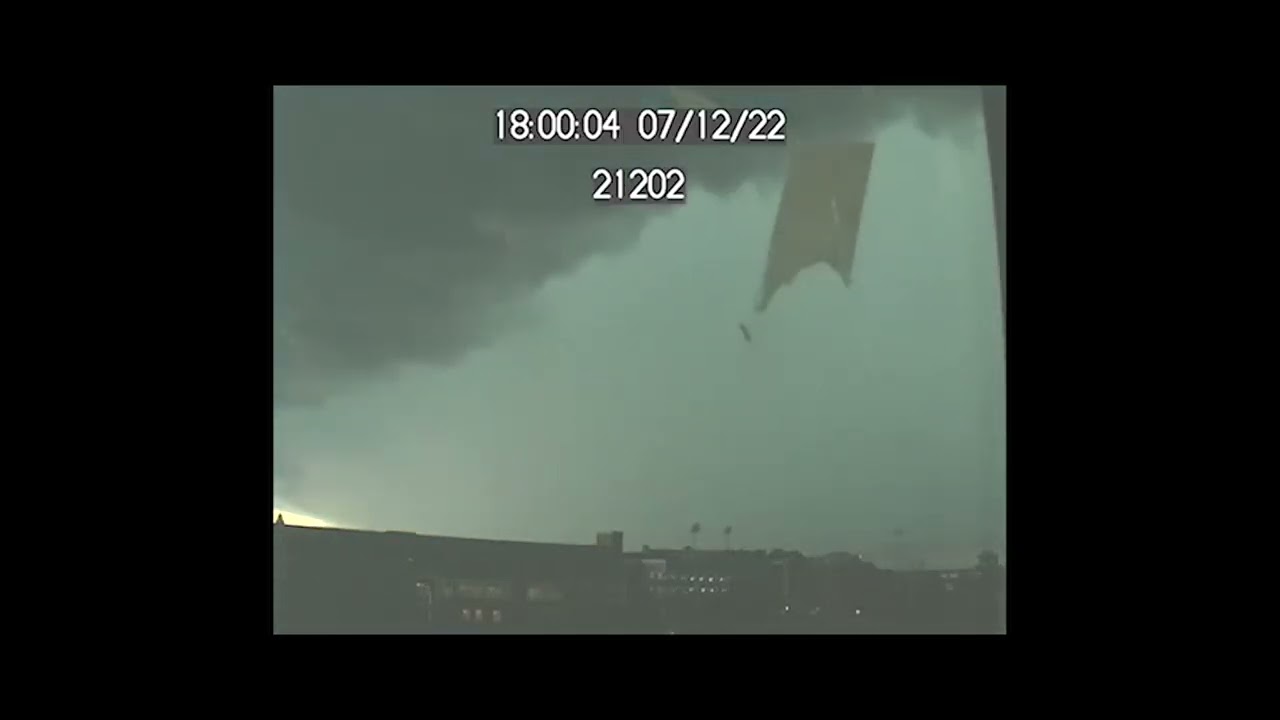Lightning and Atmospheric Electricity
Our research focuses on understanding the physical processes within individual lightning flashes and the mechanisms behind storm electrification. We study lightning structures and patterns using advanced remote sensing techniques, including lightning mapping arrays, radio frequency detection systems, and satellite-based sensors. Additionally, we investigate global lightning activity and its impact on weather, climate, infrastructure, and natural disasters such as wildfires, which are often triggered by lightning strikes. By studying these interactions, we aim to better understand the role of lightning in shaping environmental and societal outcomes around the world.
UND Faculty/Staff Researchers: David Delene, Montana Etten-Bohm, Shawn Wagner, Daile Zhang
Linking Electric Field Measurements and Fog Events: Investigating a Novel Approach to Enhance Fog Weather Prediction
This project aims to advance our understanding of fog formation and behavior by measuring electric field changes during fog events in Grand Forks, North Dakota. Using high-resolution portable Electric Field Mills (EFMs), we will collect data on atmospheric electric fields during fog events, including unprecedented measurements during ice or snow fog events. The study will analyze patterns and correlations between electric field changes and fog conditions, assess implications for fog forecasting, and explore the feasibility of integrating EFM technology with balloon launches, Unmanned Aircraft Systems (UASs), and small aircraft for future field campaigns.
Contact: David Delene, Shawn Wagner, Daile Zhang
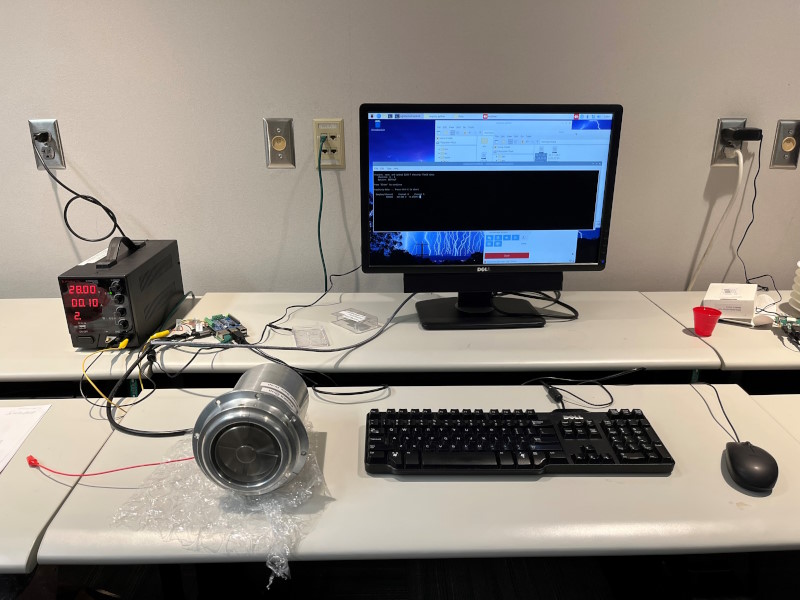
An electric field mill tested in the lab with a reading on the monitor.
Observation of Lightning and Other Phenomenon Using Raspberry Pi, All-Sky, and High-Speed Cameras
A variety of camera networks are used to observe lightning, meteors, and aurora. A Raspberry Pi-based camera network with 16 cameras was set in 11 locations across the United States (Maryland, North Carolina, Texas, Oklahoma, Arizona, and Colorado). Videos were taken at 90 fps to see the subprocesses of individual lightning flashes, such as return strokes and continuing current. Videos were used as "ground-truth" for evaluating the performance of Geostationary Lightning Mappers (GLMs) on the GOES satellites. Recently, an all-sky camera network has been installed at Clifford Hall to observe both lightning and meteors.
Contact: David Delene, Daile Zhang
Publications
-
Pierce, T., and D. Zhang. Developing a Blended Lightning Dataset and its Applications. 2023 AMS Annual Meeting, January 2023. Denver, CO. https://ams.confex.com/ams/103ANNUAL/meetingapp.cgi/Paper/419303. Copy is available upon reasonable request.
-
Brooks, D., and D. Zhang. A Study of Lightning Climatology of the Greater Washington DC Area and the July 12, 2022 Severe Thunderstorm Event. 2023 AMS Annual Meeting Student Conference, January 2023. Denver, CO. https://ams.confex.com/ams/103ANNUAL/meetingapp.cgi/Paper/422823. Copy is available upon reasonable request.
-
Friedman, A., and D. Zhang. Developing a Raspberry Pi Camera Network to Better Observe Lightning in Washington D.C. Region and Beyond. 2023 AMS Annual Meeting Student Conference, January 2023. Denver, CO. https://ams.confex.com/ams/103ANNUAL/meetingapp.cgi/Paper/422622. Copy is available upon reasonable request.
Media
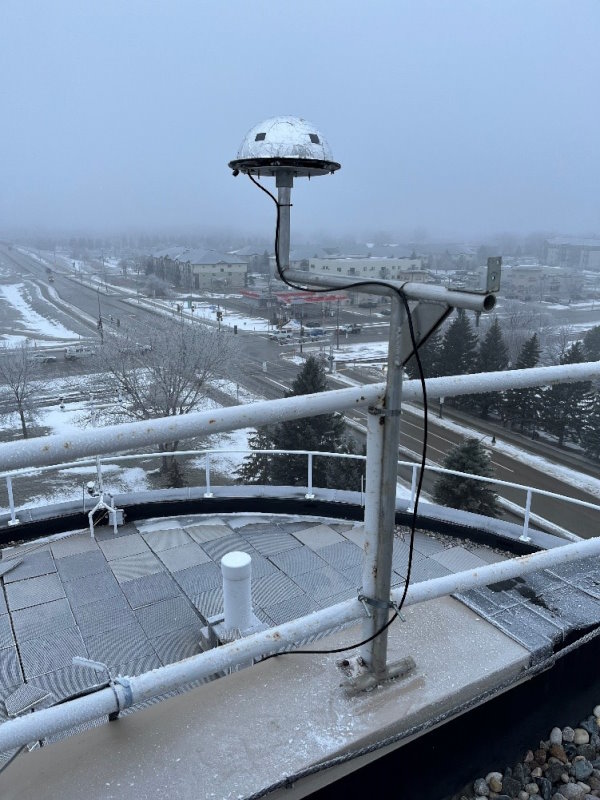
All-Sky camera on Clifford Hall.
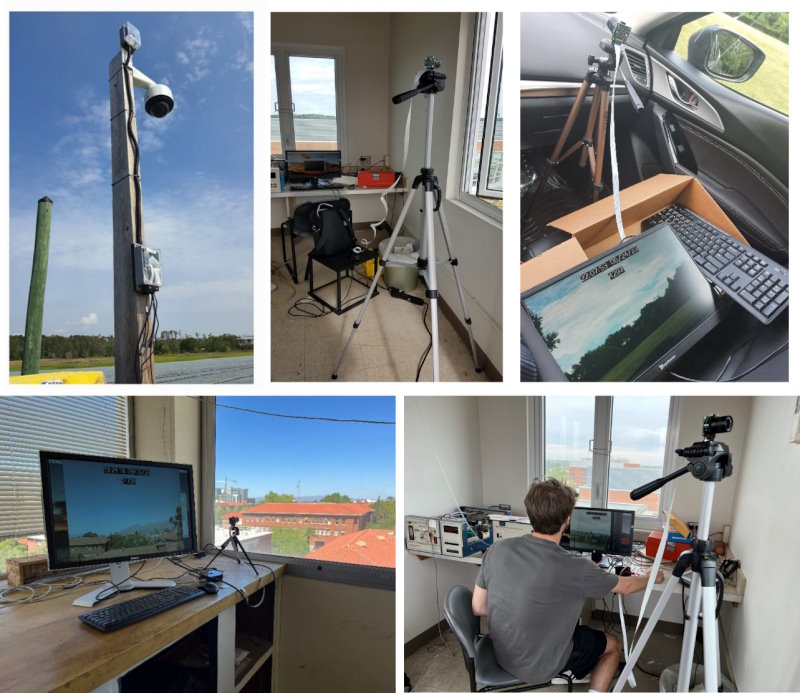
Example photos of the Raspberry Pi camera network. Top left: outdoor station at Wilmington, NC. Top middle: indoor station at College Park, MD. Top right: portable station at Greenbelt, MD. Bottom left: indoor station at Tucson, AZ. Bottom right: A former student at the University of Maryland working on the camera.
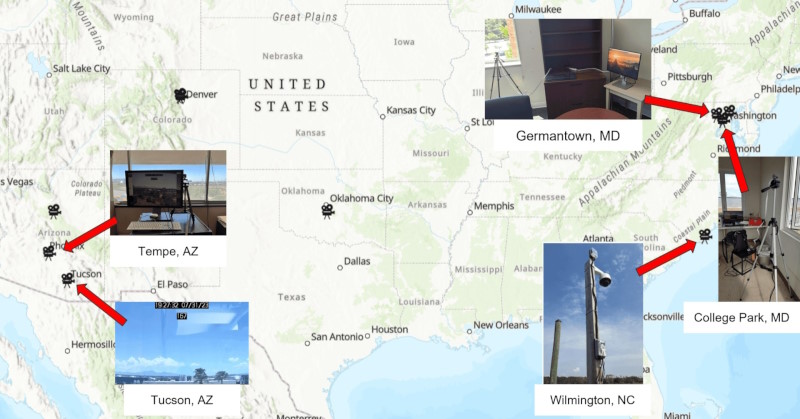
Map of the Raspberry Pi camera network across the country.
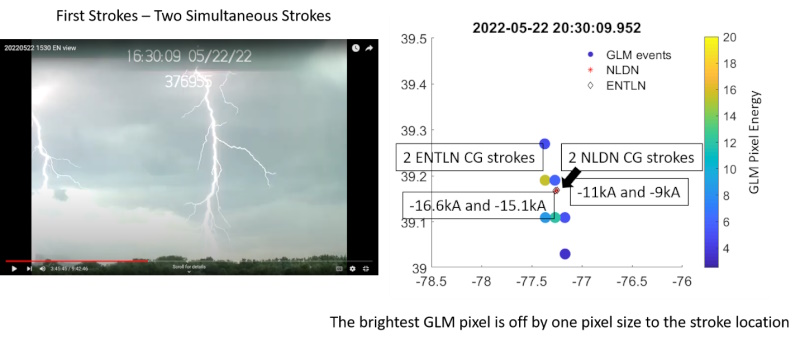
An 8-stroke flash detected by all lightning networks. Left panel: The first strokes captured by a Raspberry Pi camera. It was a cloud-to-ground lightning, which had two simultaneous strokes. Right panel: The plan view of the same lightning observations from Geostationary Lightning Mapper (GLM, dots, color-coded by pixel energy), National Lightning Detection Newtork (NLDN, red stars), and the Earth Network Total Lightning Network (ENTLN, black diamonds).
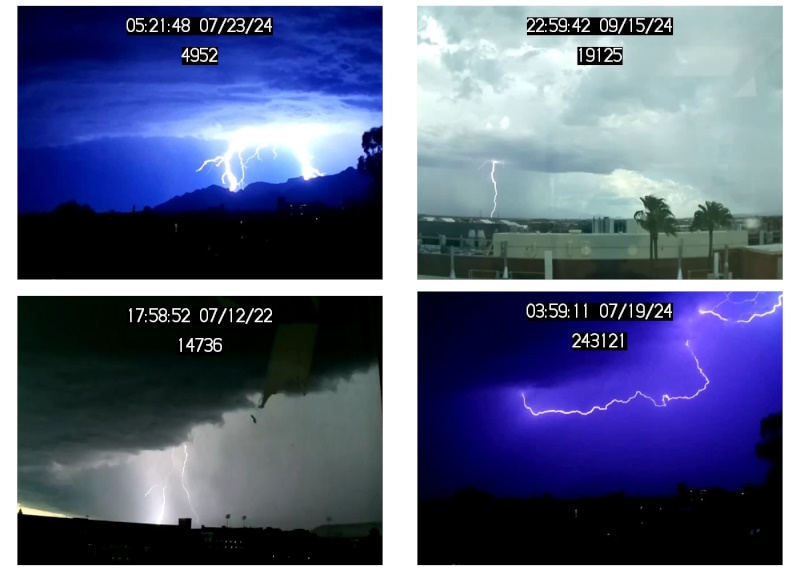
Sample lightning photos captured by the Raspberry Pi camera network (Courtesy of Daile Zhang).
Evaluation and Intercomparison of Lightning Detection Networks
Lightning emits electromagnetic signals across a wide spectrum, with each detection network specialized to capture a specific frequency range. We use multiple advanced remote sensing techniques to study lightning patterns and behavior: lightning mapping arrays (LMAs) for detailed flash structures, radio frequency detection systems like the National Lightning Detection Network (NLDN) and/or Earth Networks Total Lightning Network (ENTLN) for ground strikes, and satellite-based sensors such as Geostationary Lightning Mappers (GLMs) for total lightning activity. By combining data from these complementary networks, we create a comprehensive picture of lightning behavior.
Contact: Daile Zhang
Publications
-
Zhang, D., K.L. Cummins, T.J. Lang, D. Buechler, and S. Rudlosky. (2023). Performance Evaluation of the Lightning Imaging Sensor on the International Space Station. Journal of Atmospheric and Oceanic Technology, 40(9), 1063-1082. https://doi.org/10.1175/JTECH-D-22-0120.1.
-
Zhang, D. and K.L. Cummins. (2020). Time Evolution of Satellite‐based Optical Properties in Lightning Flashes, and its Impact on GLM Flash Detection. Special Issue of Journal of Geophysical Research: Atmospheres, 125(6). https://doi.org/10.1029/2019JD032024.
-
Peterson, M., S. Rudlosky, and D. Zhang. (2020). Changes to the Appearance of Optical Lightning Flashes Observed from Space According to Thunderstorm Organization and Structure. Journal of Geophysical Research: Atmospheres, 125(4). https://doi.org/10.1029/2019JD031087.
-
Peterson, M., S. Rudlosky, and D. Zhang. (2020). Thunderstorm Cloud-Type Classification from Space-Based Lightning Imagers. Monthly Weather Review, 148(5), 1891-1898. https://doi.org/10.1175/MWR-D-19-0365.1.
-
Zhang, D., K.L. Cummins, P. Bitzer, and W.J. Koshak. (2019). Evaluation of the performance characteristics of the Lightning Imaging Sensor. Journal of Atmospheric and Oceanic Technology, 36(6), 1015-1031. https://doi.org/10.1175/JTECH-D-18-0173.1.
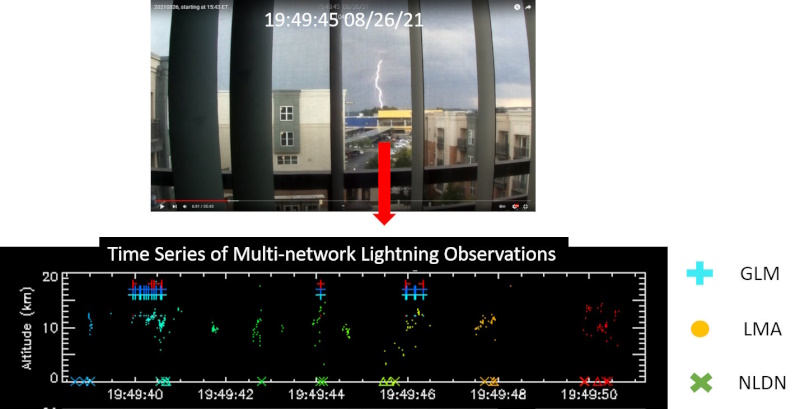
Upper panel: A cloud-to-ground stroke captured by a Raspberry Pi camera on Aug. 26, 2021. Lower panel: A time series of about 10 seconds of the data from multiple lightning networks including GLM (plus signs), LMA (dots), and NLDN (crosses and triangles). The LMA and NLDN symbols are color-coded by time. The large red arrow indicates the time when the frame in the upper panel occur (19:45:45).
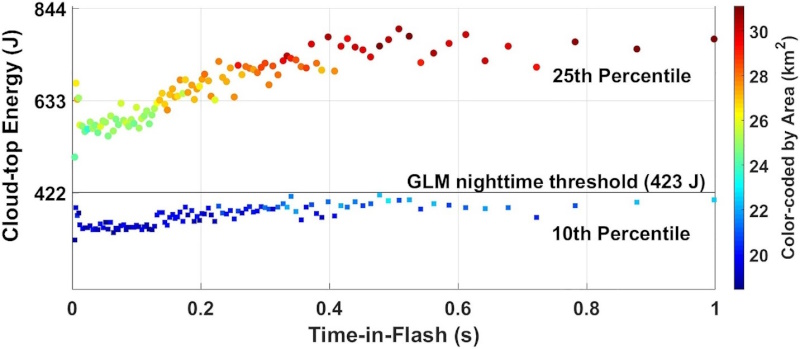
Time evolution of group cloud-top energy (joules) in the 10th and 25th percentiles, color-coded by the group area for LIS IC flashes. The black line shows the GLM nighttime threshold, which is 423 J. This figure explains why a satellite-based lightning sensor called Geostationary Lightning Mapper (GLM) tends to have a lower detection on smaller/shorter lightning occurrences. The GLM detection threshold, which is labeled as a black line in the figure is 423 Joules. Anything lower than the threshold (blue dots, small and low-energy lightning sources from space) will not be detected by GLM.
Projecting Future Lightning
Lightning is an important atmospheric process for generating reactive nitrogen, resulting in production of tropospheric ozone, as well as igniting wildland fires, which result in potentially large emissions of many pollutants and short-lived climate forcers. Lightning is also expected to change in frequency and location with the changing climate. As such, lightning is an important component of Earth system models, implemented as lightning parameterizations.
Etten-Bohm et al. (2021; EB21) established a new lightning parameterization based solely on large-scale environmental variables, including convective available potential energy (CAPE), lifting condensation level (LCL), and column saturation fraction (r). The parameterization, which uses a logistic regression, predicts lightning occurrence accurately up to 86% of the time, and while there are regions of overprediction and underprediction, the lightning parameterization performance shows promising potential for use in GCMs. Whaley et al. (2024) further utilized the EB21 lightning parameterization within the Canadian Earth System Model (CanESM). The modeled lightning was evaluated against satellite measurements over the historical period and model biases were found to be acceptable, within a factor of two of the measurements and an exceptionally accurate land/ocean ratio.
Most recently, Etten-Bohm et al. (2025) evaluated the EB21 lightning parameterization for present-day (2017-19) and end-of-century (2098-2100) RCP8.5 climate scenarios in the Community Atmosphere Model version 5 (CAM5). The end-of-century prediction shows relative increases of about 50% over higher-latitude land, but much more variable increases and decreases across mid-latitude ocean and the tropics such that the overall global lightning occurrence is expected to slightly decrease (see figure below).
Contact: Montana Etten-Bohm
Publications
-
Etten‐Bohm, M., Yang, J., Schumacher, C., & Jun, M. (2021). Evaluating the Relationship Between Lightning and the Large‐Scale Environment and its Use for Lightning Prediction in Global Climate Models. Journal of Geophysical Research: Atmospheres, 126(5). https://doi.org/10.1029/2020JD033990
-
Whaley, C., Etten-Bohm, M., Schumacher, C., Akingunola, A., Arora, V., Cole, J., et al. (2024). A new lightning scheme in the Canadian Atmospheric Model (CanAM5.1): implementation, evaluation, and projections of lightning and fire in future climates. Geoscientific Model Development, 17(18), 7141–7155. https://doi.org/10.5194/gmd-17-7141-2024
-
Etten‐Bohm, M., Schumacher, C., Xu, Y. & Funk, A. (2025). Projection of Global Future Lightning Occurrence using only Large-Scale Environmental Variables in CAM5. Geophysical Research Letters. Submitted.
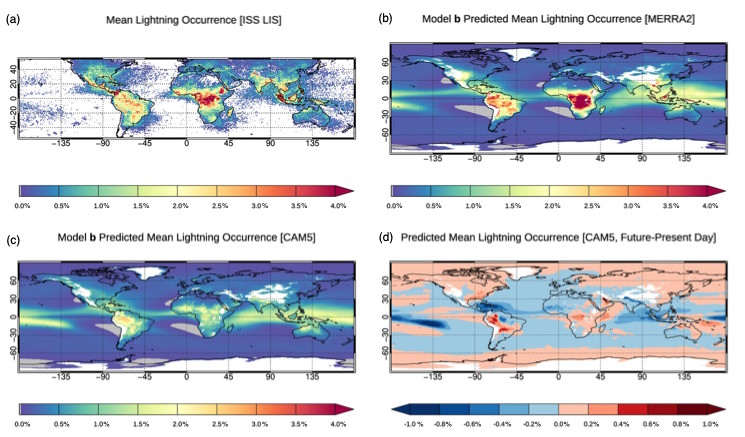
Adapted from Etten-Bohm et el. (2025). Present-day (2017-19) lightning occurrence (in %) from (a) ISS LIS observations and (b) MERRA-2 and (c) CAM5 predictions using the EB21 parameterization. (d) CAM5 lightning occurrence difference between end-of-century (2098-2100) and present-day.
Lightning Hazards, Lightning Safety, and Its Societal Impacts
The world experiences a large number of lightning casualties per year (e.g., an estimate of 24,000 fatalities around the globe annually, Holle, 2008). However, lightning-related incidents are often underreported in Africa as well as South and Southeast Asia, where lightning kills more people per capita annually than many other natural disasters. This deadly situation is compounded by poor infrastructure, limited warning systems, and inadequate public education. Agricultural activities, which are central to many livelihoods, further increase vulnerability during thunderstorms. With advancements in lightning observation systems, there is potential to revolutionize lightning observation and improve forecasting across these areas. However, challenges persist, including the need for expanded research, education, and more effective communication strategies. Deeply-rooted cultural beliefs often lead to misperceptions about lightning and incorrect responses to the threat, influencing unsafe behaviors. We work with the World Meteorological Organization (WMO), and scientists/engineers across more than 25 countries in Asia, Africa, Europe, and North and South America to highlight the importance of international collaboration and knowledge sharing in improving resilience to natural hazards. We also organize and host the annual International Lightning Safety Day (ILSD) meetings on June 28.
Contact: Montana Etten-Bohm, Daile Zhang
Publications
-
Holle, R.L., and D. Zhang. (2023). Flashes of Brilliance: The Science and Wonder of Arizona Lightning, Springer. https://doi.org/10.1007/978-3-031-19879-3.
-
Zhang, D. and R. Holle. (2024). Lightning Casualties of Vulnerable Caterpillar Fungus Collectors on the Qinghai–Tibetan Plateau. Weather, Climate, and Society, 16(4), 611-620. https://doi.org/10.1175/WCAS-D-23-0117.1.
-
Zhang, D. and R. Holle. The Epidemiology of Lightning in Mainland China - A Review of Two Datasets from the 1950s to 2018. 36th International Conference on Lightning Protection, October 2022. Cape Town, South Africa. https://doi.org/10.1109/ICLP56858.2022.9942574.
-
Peterson, M.J., T.J. Lang, T. Logan, C. Wee Kiong, M. Gijben, R. Holle, I. Kolmasova, M. Marisaldi, J. Montanya, S.D. Pawar, and D. Zhang. (2022). New WMO Certified Megaflash Lightning Extremes for Flash Distance and Duration Recorded from Space. Bulletin of the American Meteorological Society, 103(5), E1243-E1247. https://doi.org/10.1175/BAMS-D-21-0254.1.
News Articles
- Zhang, D., (2025). Lightning strikes make collecting a parasitic fungus prized in traditional Chinese medicine a deadly pursuit, The Conversation. https://theconversation.com/lightning-strikes-make-collecting-a-parasitic-fungus-prized-in-traditional-chinese-medicine-a-deadly-pursuit-243236.
Media
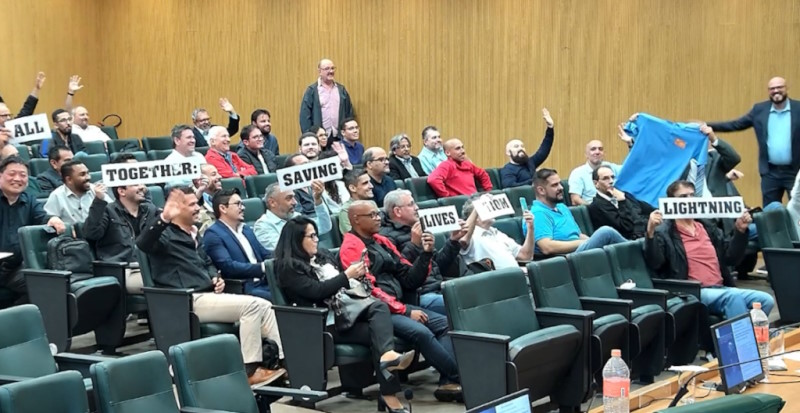
2024 International Lightning Safety Day (ILSD) at the University of São Paulo (Courtesy of Hélio Eiji Sueta).
Protecting Our Community: Lightning Safety in Grand Forks and Beyond
This initiative aims to significantly reduce lightning-related risks in Grand Forks through a comprehensive education and awareness program. By combining the expertise of the Principal Investigator, UND student learning opportunities, collaborations with the local National Weather Service (NWS), and community engagement, we will implement a multi-faceted approach to improve public lightning safety and awareness. The program includes public awareness events, educational material development, implementation of safety measures, and media engagement.
Contact: Montana Etten-Bohm, Daile Zhang
